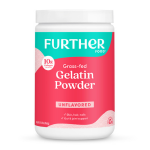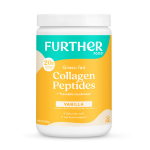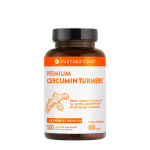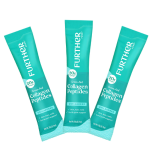Are you eating enough fiber through prebiotic foods? In this article, integrative nutritionist Nicole Magryta explains why we need to make sure we get enough prebiotic fiber from prebiotic foods in our diets. Not only do prebiotic fiber foods help to improve digestion and blood sugar levels, but they help promote the increase of healthy gut bacteria and a strong microbiome. Learn more about their health benefits and get a prebiotic food list that shows you the top gut-supporting prebiotic foods you should be eating today!
FEED THE GOOD BACTERIA
Your decisions at the dinner table—or the drive-through—tweak your microbial balance with every meal. In as little as 24 hours, we can change the functionality and abundance of bacteria, depending on what we choose to feed them. Remember, they eat what we eat. If we choose foods that the beneficial gut bacteria thrive and multiply on, we in turn produce an environment that promotes health and fights disease. To accomplish this we must eat their food of choice: fiber. Dietary fiber is known to help bulk up stool, reduce hunger, increase colonic movement, reduce cardiovascular disease and metabolic syndrome, improve diabetes, reduce cancer and inflammation, improve blood sugar levels, and so on.
Okay, there I said it, the “f” word. Dietary fiber is undoubtedly the chief operating substance of our digestive system. Also known as roughage, fiber is the indigestible portion of plant foods. You may be surprised to know that American children and adults consume woefully inadequate quantities of fiber in their diets. The average American consumes about 15 g of fiber each day, and most of it is eaten in the form of refined flours, grains, and potatoes.
The Institute of Medicine recommends 25 g of fiber per day for women and 38 g for men. For my patients and clients, I often recommend trying to consume at least 40–50 g of fiber per day, which may sound like a lot, but when compared to the 100 g our ancestors ate, it’s really a drop in the bucket. Historically, humans consumed large volumes of fiber as vegetables, fruits, whole grains, roots, and tubers. The advent of refined and processed foods has dramatically reduced our fiber intake to less than 10 percent of historical norms for many Americans; It’s no surprise that our gut ecosystems have changed in concert.
Prebiotic Foods
For years, we have broadly categorized fiber on a nutrition label as insoluble, meaning it does not dissolve in water and soluble, meaning that it does. Almost all plant foods have both soluble and insoluble fibers but in different proportions. For instance, the fiber in kidney beans is 30 percent insoluble and 70 percent soluble, while wheat is about 90 percent insoluble, and oats are 50⁄50. But it wasn’t until 1995 that nutrition researchers discovered something quite remarkable about certain soluble fibers: while all fiber remains unchanged until it reaches the large intestine, only some fibers are fermented by our beneficial gut bacteria as a food source. We call these fibers prebiotics.
The human gastrointestinal tract allows us to extract and absorb nutrients from protein, fats, and simple sugars in the small intestine, which resides between the stomach and the large intestine. Complex carbohydrates like fiber and some starches, however, take a different route. When we eat carbohydrates, the body passes the indigestible fibers through to the large intestine, where trillions of microbes live. It is here that fiber is fermented and devoured by friendly gut bacteria, stimulating their growth, improving the gut barrier function, and enhancing SCFAs production, which are critical for health. If we starve our microbes of fermentable prebiotic fibers the consequences can be toxic. Not only will our friendly bacteria stop producing the multitude of beneficial functions required for our survival, but their resulting death will pave the way for harmful bacteria to break down our intestinal wall and create low-grade inflammation that can lead to a host of chronic diseases.
Understanding the Benefits of Prebiotic Foods
It has long been established that societies that eat large amounts of whole plant foods tend to be healthier with less occurrence of disease, but we didn’t necessarily know why. Now we do, and fiber plays a starring role. Some of the most fascinating research comes from Dr. Patrice Cani, a Belgium-based microbiologist who studies the connection between inflammation and gut microbes. He found that feeding a high-fat, “junk food” diet to mice resulted in weakened gut barriers, which led to leaky guts and low-grade inflammation. Even more intriguing, when he fed gut-friendly prebiotic plant fibers to mice on a high-fat diet, he was able to stop the inflammation cascade associated with obesity, insulin resistance, and a host of other metabolic diseases. In my opinion, the single most important strategy for improving the diversity and health of our gut microbiome is to consume large quantities of whole plant foods loaded with fiber.
Currently, the best-studied prebiotic fibers are carbohydrate compounds such as polysaccharides, oligosaccharides, inulin, oligofructose, lactulose, resistant starch, and other isolated carbohydrates. These different prebiotic types feed different species of gut bacteria, which offer us different health benefits. A diet that includes these fermentable fibers is one that includes various fruits, vegetables, nuts, seeds, and whole grains. In addition, many of these foods also contain special antioxidants called phenols that inhibit the growth of harmful bacteria and help beneficial bacteria tame inflammation.
Below is a list of the top foods that contain the best prebiotic fibers and gut-supporting dietary phenols. The list also includes herbs and spices that have been reported to kill pathogenic bacteria such as H. pylori.
TOP PREBIOTIC FOODS

Excerpted from Nourish Your Tribe: Empowering Parents to Grow Strong, Smart, Successful Kids. Copyright 2018 by Nicole Magryta, RDN. All rights reserved.
Want to read more?
10 Superfoods for a Happy, Healthy Gut
7 Foods That Heal Your Leaky Gut in 14 Days From an Expert Who Did It Herself!

























